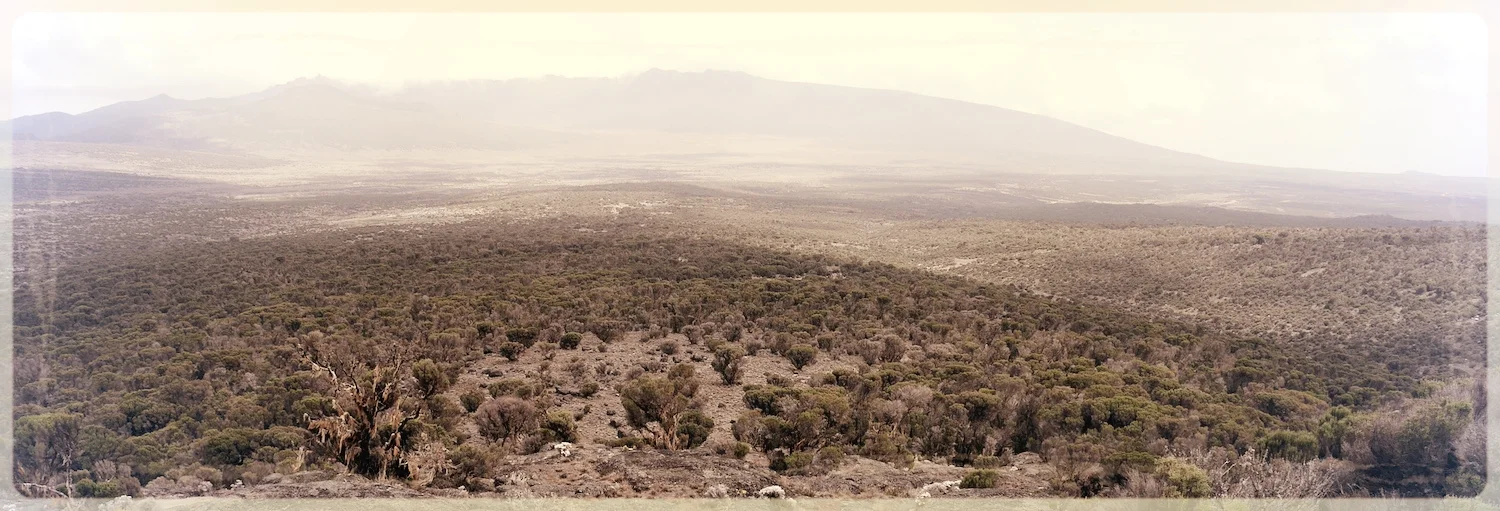Kilimanjaro rests at the southern end of the Great Rift System. Given this crust-scrunching scenario, it is not surprising that the mountain has been a work-in-progress for eons. Three major blowholes are obvious; experts count hundreds more.* Kibo is the highest of the three major vents and the youngest of the trio. Shira is the old sister; she wore out and collapsed (~ 1.9 Ma) long before Kibo showed up to the tectonic dance (~ 1 Ma).** Consider the schematic below.
One can see how the emissions of Kibo obscure the true nature of the Shira. Image from George Salt, The Shira Plateau of Kilimanjaro. The Geographical Journal 117/2 (Jun 1951): 150. Incidentally, it was Fritz Klute who first identified the "Schiraplateau" in print. The name stuck.
Our immediate goal was to climb from the forest camp (elevation 9,137 feet) to the Shira Plateau. The plateau is actually a partially infilled caldera. The simplest route skirts north around the pinched lip that defines the caldera's western rim, often called the Shira Ridge. Our next camp would be in the caldera itself.
The goal for the day is to hike up and over the Shira Ridge.
Leaving the humid forest behind we followed the trail into the upland. Hills crested like rolling waves -- 9,000 feet, 10,000 feet, 11,000 feet -- up and up, toward the Shira Plateau. The vibe is that of a California chaparral, although our British contingent speak of it as a moorland. Whatever the analogy, these slopes mark the transition between forest and alpine desert on Kilimanjaro.
The sun was intense. Have I just grown accustomed to the shadow of the forest? Is it the elevation? I retreated behind dark glasses and globbed on the sunscreen. Before me was blue sky and the mottled landscape of rock slabs, junipers, and clumping grasses. These were interrupted by flashes of flowers or the fluttering wings of small birds.
Conditions in this sub-alpine upland can be brutal. Moisture often falls only as mist, temperatures swing from blazing to freezing, often on the same day. Adaptation or death are the choices in this erratic environment.
Hills crested like rolling waves.
I peppered the guides with biome questions and stopped repeatedly to photograph flowers. The set of life here is limited. Long-term residents include small mammals and a few birds. Rarely, antelope, elands, elephants, buffalo, and even lions are spotted.
The possibility of a lion encounter was teasing. Could this have been what Robert referred to back in the forest camp? In the not-so-distant past, a rifleman was standard issue for groups traveling this route. The narrow hallway of shrubs is tall and dense. I let that thought go. It is unhelpful. Cool, but unhelpful.
"Everlastings" appears all the way up to 15,000 feet.
The flowers were beautiful. Members of the Helichrysum family are certainly not pansies! They are one of the tougher residents of Kilimanjaro's slopes. Nicknamed "Everlastings," or "Mountain Daisies," I noted several varieties. The white-pointed petals of H. Newi grow from pale stems in tight clusters. Its leaves are small and hairy to help preserve moisture. Other varieties bloomed in yellow and brown or red and pink.
Perhaps the most exotic-looking flower of the mountain was from the family Proteaceae. The protea is a dinosaur of the plant family; its ancestors hail from the days when T. Rex chomped on hapless hadrosaurs (Yes, that would be more terrifying than a lion in the heather!). When opened, the flower of the P. kilimandscharica, sometimes called the "Alpine Sugarbush," looks like a single flower. In truth, it is a cluster of flowers tightly packed into a single head. Again, waxy leaves help this plant survive in a moisture-poor environment.
The flower-head of the Protea kilimandscharica resembles an artichoke at a glance. When it opens it is beautiful.
Our line trudged up one more rise. At the crest, the landscape flattened. It was the collapsed floor of the Shira caldera. Kibo arose on the far side of the plateau. One phase of our trek was concluding, but another was about to begin.
View to Kibo from the western edge of the Shira Plateau.
I love Africa but my regular summer work is in Israel-Palestine.
If you are a pastor, church leader, or educator who is interested in leading a trip to the lands of the Bible, let me hear from you. I partner with faith-based groups to craft and deliver academic experiences. Leaders receive the same perks that other agencies offer, at competitive prices, and without the self-serving interests that often derail pilgrim priorities.







